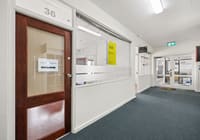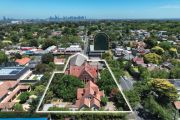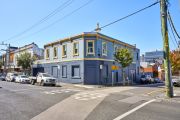
Blue Sky lodges plans for 276-bed student accommodation in Kensington
Student accommodation provider Blue Sky Alternative Investments has lodged plans to build its first property in NSW, in a proposal estimated to cost about $24 million.
Blue Sky wants to redevelop a row of five residential properties and an adjoining vacant lot in Kensington, near the University of New South Wales, into a 276-bed facility, on about 4300 square metres.
It is proposing to demolish three properties at numbers 4-8, 14 and 16 Doncaster Avenue, which will be amalgamated with the vacant lot at number 18, to make way for the development, which is classified as state-significant.
Meanwhile, the local heritage-listed Victorian filigree terraces at 10 and 12 will be retained. Under the plans, designed by architects Hayball, the pair of terraces will be integrated into the development but the newer building additions to the rear will be removed.
The terraces, built about 1896, have a history of being used as a stables or a riding school in connection with the Randwick Racecourse.
The site backs on to the recently developed Randwick Stabling Yard, where trams for the new light rail line will be stored and maintained. Behind that yard is the Randwick Racecourse.
Blue Sky has acted quickly to submit plans on the land, which it purchased for $23.5 million in September 2018. The site previously had approval for a residential development with 50 units.
If approved the purpose-built student housing development, dubbed Atira Doncaster Avenue, will open in January 2021 and be managed by Atira, which is a joint venture between Blue Sky and Goldman Sachs.
The Kensington site will be the first Atira-managed student housing property in NSW, “in-part due to a competitive residential market”, according to the application. The group operates facilities in Brisbane, South Australia and Victoria.
While barriers to entering Sydney’s student accommodation market are higher than other cities, about 6500 student beds are either proposed or under construction in the city, a 35 per cent boost on current supply, according to Colliers International’s PBSA Research Insights Report 2018.
The three-storey Kensington project will have some 6000 square metres of accommodation space, with almost 900 square metres of indoor and outdoor communal areas.
Of the 276 beds, 127 of them are within single studios, which are each about 18 square metres. Beds are also configured in twin studios, as well as clusters of multiple bedrooms.
Communal facilities include kitchens, meeting spaces, study areas, lounge rooms, games areas, a gym, outdoor barbecue space and laundry. While studios have their own ensuites, clusters will have shared bathrooms.
The development will also provide a reception area, as well as basement parking spaces for 56 cars, 54 motorcycles and 60 bicycles.
Blue Sky did not respond to requests for comment in time for publication.
Nicholas Efrossynis, co-director of Laing and Simmons Kingsford, said local demand for student accommodation had been ramping up in recent years, not only in Kensington but also in neighbouring Kingsford and Randwick, and this was despite the cooling housing market.
“The downturn in the residential market overall has softened the market but for this sector of the marketplace, it basically almost has its own legs in the sense that students are still coming; no matter what’s happening in the rest of the economy, there’s still a certain intake.”
Prime net yield for student housing in Australia is 6.75 per cent, according to Savills’ Global Living 2018 report, but yields have “compressed in recent years as investor demand has grown against a backdrop of limited supply”.
The university – which has nearly 60,000 students, a third of whom are from overseas – expressed support for Atira Doncaster Avenue in a letter forming part of the development application, citing its “broader strategy to increase the accommodation options available to UNSW students”.
Despite the demand for student housing, Mr Efrossynis, who has been working in the area for more than 40 years, expects the scale of the project could “upset some long-term residents”.
“But there are others in the investor spectrum who will welcome it. I don’t know if there’s a model that suits everyone, to keep everyone happy, but progress can divide communities.”
The application is on public exhibition until March 6.












